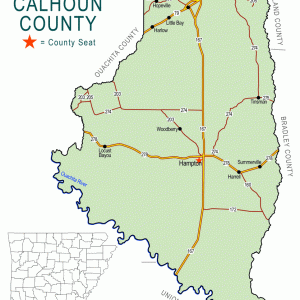calsfoundation@cals.org
Tinsman (Calhoun County)
| Latitude and Longitude: | 33°37’47″N 092°21’19″W |
| Elevation: | 177 feet |
| Area: | 0.53 square miles (2020 Census) |
| Population: | 50 (2020 Census) |
| Incorporation Date: | October 11, 1909 |
Historical Population as per the U.S. Census:
| 1810 | 1820 | 1830 | 1840 | 1850 | 1860 | 1870 | 1880 | 1890 | 1900 |
| – | – | – | – | – | – | – | – | – | – |
| 1910 | 1920 | 1930 | 1940 | 1950 | 1960 | 1970 | 1980 | 1990 | 2000 |
| – | 248 | 177 | 258 | 118 | – | 113 | 112 | 69 | 75 |
| 2010 | 2020 | ||||||||
| 54 | 50 |
Tinsman is a town in eastern Calhoun County. Once important as a junction for the Rock Island Railroad, the town has faded considerably since the decline of the railroad.
Until the arrival of European and American settlers, the forested hills of Calhoun County were only sparsely settled, although the Caddo lived in the area perhaps as much as 5,000 years ago. Covered with pine, oak, cypress, red gum, and hickory trees, the region was not welcoming to early settlers, although some did arrive in the 1840s and 1850s, mostly from Alabama, Georgia, and Tennessee. Calhoun County was largely untouched by the Civil War, although roughly 400 men from the county fought in the war, most of them for the Confederacy.
Late in the nineteenth century, the Choctaw, Oklahoma and Gulf Railroad began construction of tracks in Calhoun County. In 1904, the railroad was purchased by the Chicago, Rock Island and Pacific Railroad (generally called the Rock Island). Railroad construction linked the major cities of Arkansas to one another and spurred the development of new cities at the same time. A junction was created at the present location of Tinsman, with a main line going north to Little Rock (Pulaski County), then branching to extend service on one line to Camden (Ouachita County) and on the other line to Junction City (Union County). Stores and homes were built at the junction, as well as a railroad depot. The U.S. Postal Service opened a post office at that site in 1906, and the town was incorporated in 1909. No record exists to explain the origin of the town’s name, but it likely was named for a railroad executive or worker.
The community continued to grow, and a school was built in 1920. That school building was listed on the National Register of Historic Places but was subsequently demolished. Churches and a sawmill were also constructed, and the population had exceeded 250 residents by 1940.
The growth trend then reversed for Tinsman. The hardwoods had been harvested and were not replaced, and railroad traffic began to be displaced by vehicular traffic. Highway 274, which runs through Tinsman, made it easy for drivers to travel to the county seat of Hampton (Calhoun County) or the larger city of Fordyce (Dallas County). The Rock Island Railroad reduced services, eventually becoming bankrupt and going out of business in 1980. The Tinsman School was closed in 1961—although the building continues to be used as a community center—and children began being bused to classes in Hampton. The post office was closed in 1975.
As late as 1990, Tinsman still had two church, a grocery store, and the Smith/Roberts Timber Company, but all of these, save the town’s Baptist church, had closed by the start of the twenty-first century. In 2010, the population of the town had fallen to fifty-four.
For additional information:
“Tinsman School.” National Register of Historic Places nomination form. On file at Arkansas Historic Preservation Program, Little Rock, Arkansas.
Steven Teske
Butler Center for Arkansas Studies
 Calhoun County Map
Calhoun County Map 



Comments
No comments on this entry yet.